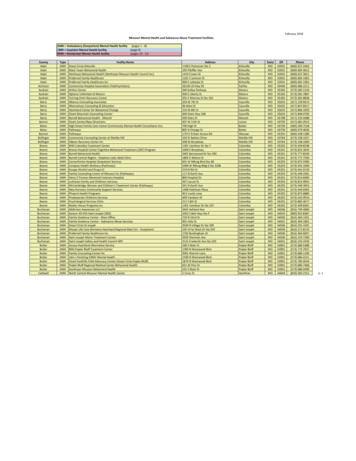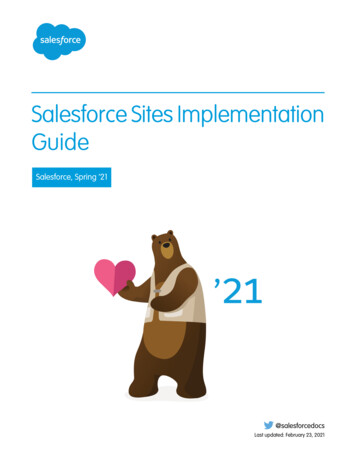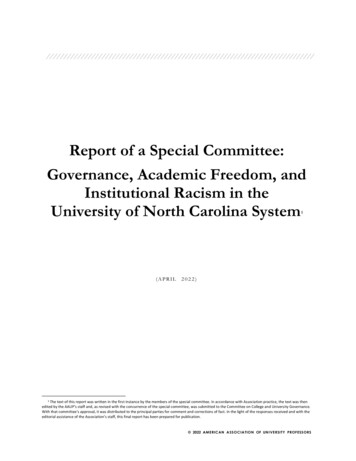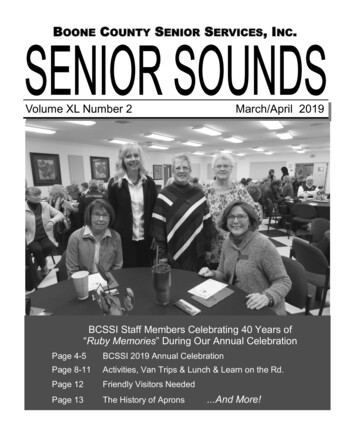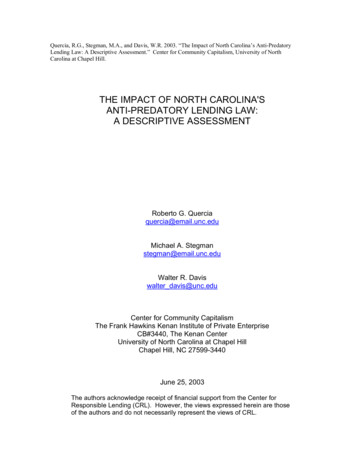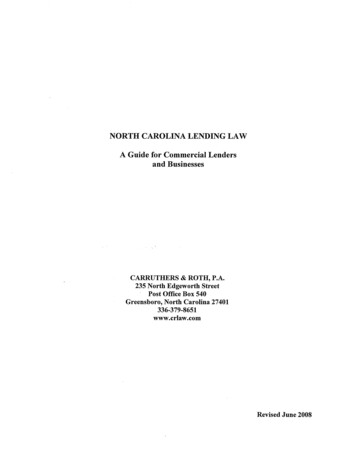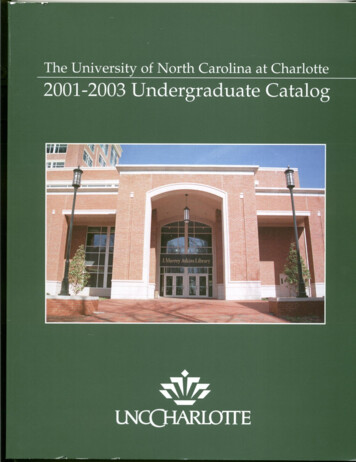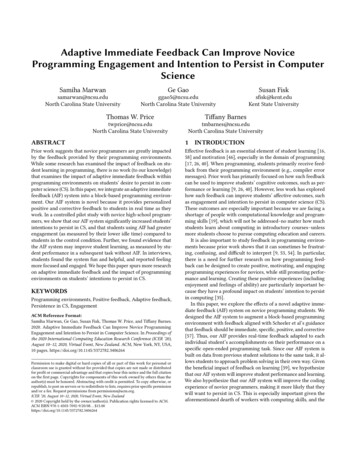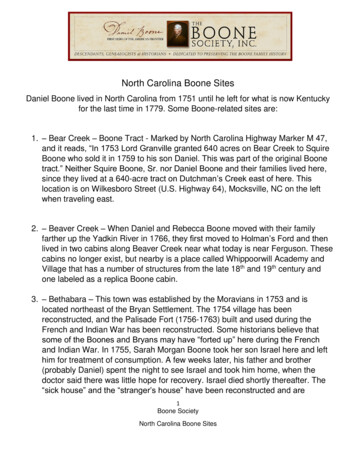
Transcription
North Carolina Boone SitesDaniel Boone lived in North Carolina from 1751 until he left for what is now Kentuckyfor the last time in 1779. Some Boone-related sites are:1. – Bear Creek – Boone Tract - Marked by North Carolina Highway Marker M 47,and it reads, “In 1753 Lord Granville granted 640 acres on Bear Creek to SquireBoone who sold it in 1759 to his son Daniel. This was part of the original Boonetract.” Neither Squire Boone, Sr. nor Daniel Boone and their families lived here,since they lived at a 640-acre tract on Dutchman’s Creek east of here. Thislocation is on Wilkesboro Street (U.S. Highway 64), Mocksville, NC on the leftwhen traveling east.2. – Beaver Creek – When Daniel and Rebecca Boone moved with their familyfarther up the Yadkin River in 1766, they first moved to Holman’s Ford and thenlived in two cabins along Beaver Creek near what today is near Ferguson. Thesecabins no longer exist, but nearby is a place called Whippoorwill Academy andVillage that has a number of structures from the late 18th and 19th century andone labeled as a replica Boone cabin.3. – Bethabara – This town was established by the Moravians in 1753 and islocated northeast of the Bryan Settlement. The 1754 village has beenreconstructed, and the Palisade Fort (1756-1763) built and used during theFrench and Indian War has been reconstructed. Some historians believe thatsome of the Boones and Bryans may have “forted up” here during the Frenchand Indian War. In 1755, Sarah Morgan Boone took her son Israel here and lefthim for treatment of consumption. A few weeks later, his father and brother(probably Daniel) spent the night to see Israel and took him home, when thedoctor said there was little hope for recovery. Israel died shortly thereafter. The“sick house” and the “stranger’s house” have been reconstructed and are1Boone SocietyNorth Carolina Boone Sites
believed to be the locations where the Boone’s stayed when here. This historicpark is owned by and located in the City of Winston-Salem at 2147 BethabaraRoad, and admission to the park is free. Learn more at historicbethabara.org4. -Boone, North Carolina- This town was named after Daniel Boone in 1849 by theNorth Carolina legislature. There is a bronze tableau sculpted by Sherry Evans ofDaniel Boone at camp on the campus of Appalachian State University inTomlinson Park on the corner of River Street and Stadium Drive and is near thesite of Boone’s hunting cabin. Inside the U.S. Post Office in downtown at 680 W.King Street on the east wall of the lobby is a mural created in 1939 by AlanTompkins of Stratford, Connecticut, and it depicts the town namesake, DanielBoone. Also located in the Town of Boone is the Hickory Ridge Museum and theperformance of the “Horn in the West” at the Daniel Boone Amphitheatre at 591Horn in the West Drive just off U.S. 321. Although not historically accurate, theirwebsite indicates that this outdoor drama portrays the life of “hardy pioneerswho, with the help of famed frontiersman, Daniel Boone, the Cherokee allies,settled in the Blue Ridge wilderness as they sought freedom from Britishtyranny.”5. - Boone’s Cave Park - This 100-acre county park is located just west of the Cityof Lexington and on the east side of the Yadkin River. There is documentationshowing that Squire and Sarah Morgan Boone owned land and lived here beforepurchasing two additional 640-acre tracts from Lord Granville on the west side ofthe River around 1752 and then settled on the Dutchman’s Creek tract. Today,the park provides an example of what the Boones and other settlers found whenthey settled on the Forks of the Yadkin. The park has a reconstructed 18thcentury log cabin, a large cave and “Baptism Rock” along the river, a DanielBoone Memorial Marker, hiking trails, a picnic area and access to the YadkinRiver for fishing, canoeing and kayaking. It’s located 3.4 miles off N.C. Highway150 on Boone’s Cave Road.6. - Boone’s Ford - This ford on the Yadkin River is named after one of DanielBoone’s cousins and is located below the “horse shoe neck” on the river.According to sources currently unproven, but “it can be argued that the earliestrepresentation of the Trading Path to the Catawba (Mosley Map, 1733) crossedthe Yadkin not at the Trading Ford, but rather at Boone’s Ford. The approaches2Boone SocietyNorth Carolina Boone Sites
to Boone’s Ford are on private land. If one paddles down the Yadkin on theDaniel Boone Heritage Canoe Trail, it is marked as Cairn number seven.7. – Boone Memorial Marker – This bronze plaque mounted to stone is a memorialto Daniel Boone and his parents Squire and Sarah Boone. It was installed by theBoone Trail Highway Association at the intersection of Main Street and CourtSquare in Mocksville, and it is on the left when traveling south on Main Street.8. – Daniel Boone Heritage Canoe Trail – This is a recreation area where the BryanSettlement was located and many of the Boones, related families and othershunted and fished along the Yadkin River. Even though the river of DanielBoone’s youth has changed over time, some of the wild aspects he knew remain,and today people can experience Boone’s Yadkin by paddling it in a canoe orkayak. People can see a number of historic sites marked by Cairns along theriver, such as Cairn 3 refers to Boone’s Shoal – Big Rock Rapid where Boone issaid to have fished, and Cairn 4 where Dutchman’s Creek empties into theYadkin and is near where the Boone’s lived, and Cairn 5 points out the BooneGamelands, and Cairn 6 is at Boone Cave Park, and, finally, Cairn 7 is atBoone’s Ford, which was probably named after Daniel’s cousin. Lean more aboutthis trail at http://eTrail/BooneCanoeMapWeb.pdf9. - Fort Dobbs State Historic Site – The French and Indian War Fort at this site inthe Yadkin-Pee Dee River Basin near what is now Statesville was the onlypermanent frontier provincial fort in the colony of North Carolina. Originalconstruction began in 1755 and was completed in 1756. It was built to protectBritish settlers in the western part of what was then Rowan County, and it servedas a vital outpost for approximately fifty soldiers. Even though some authors writethat Daniel Boone and his family “forted up” here during the War, it’sundocumented and highly unlikely. However, there is a bronze Daniel Booneplaque at the site, and it’s believed he was in the area serving as a ranger and inthe militia. This fort was no longer used after 1766 and disappeared from thelandscape. A reconstructed replica of Fort Dobbs completed in 2019 nowoccupies the site at its original location. Learn more at fortdobbs.org10.– Holman’s Ford near Goshen – In 1766, Daniel and Rebecca Boonemoved with their family up the Yadkin River to this area in present day WilkesCounty. This site is now under the W. Kerr Scott Reservoir, so it is no longeraccessible.3Boone SocietyNorth Carolina Boone Sites
11.– Joppa Cemetery (formerly called Burying Ground Ridge) – At this site is aNorth Carolina Highway Marker M 3 which says, “Daniel Boone’s Parents –Squire and Sarah Boone are buried here. Daniel Boone, 1734 – 1820, livedmany years in this region.” Their son, Israel Boone is also buried here, as well asJonathan Boone in an unmarked grave, and there are a number of Wilcoxonheadstones. Squire and Sarah Morgan Boone were more than just the parents ofDaniel. They owned land at Boone Cave Park and two separate 640-acre tractsat Dutchman’s Creek and Bear Creek that were purchased from Lord Granville.As a result of his status as a property owner, Squire Boone served on thecolonial Court of Common Pleas for Rowan County from 1753 to 1757. He wasalso elected to the first Vestry of St. Luke Parish, which represented theAnglicans or Church of England in Rowan County. Squire Boone was buried atJoppa Cemetery in 1765 and Sarah Morgan Boone was buried there in 1777.Joppa Cemetery is located on the east side of U. S. Highway 601 as it goesthrough the northwest section of Mocksville.12.– Old Salem – This Moravian town founded in 1766 is located just east ofwhat were the Bryan Settlements and the Forks of the Yadkin. Moravian recordsdocument many of the Boone and Bryans visited here, and their ministersfrequently traveled through, preached and stayed with the Bryans and Boones onthe Bryan Settlement. Moravian records also document Daniel Boone’s visit herein 1778 to tell about his capture by and escape from the Shawnee in Kentucky.Old Salem is in Winston-Salem, and the old town’s restored and reconstructedbuildings are staffed by living-history interpreters to show visitors Moravian life inthe 18th and 19th century. Learn ore at oldsalem.org13.– Rowan Museum – Located in the heart of downtown Salisbury, whichwas the original colonial county seat of Rowan County, it houses and displays adoor believed to be from the first court house where Squire Boone served as aJustice from 1753 to 1757. In one of its house museums, one can find thetombstone of Martha Strode Bryan who was the grandmother of Rebecca BryanBoone, and they both traveled together for the first time into North Carolina in1748. The museum claims to hold additional Boone artifacts. Learn more atrowanmuseum.org4Boone SocietyNorth Carolina Boone Sites
14.– Sugartree Creek – Land located in what is now in northeastern DavieCounty is where Daniel and Rebecca Boone moved shortly after they were firstmarried, and it is believed to originally have been owned by one of the Bryans(Even though it’s currently undocumented, it was probably owned by Rebecca’sfather). A number of their children were born here, and they moved in 1766farther up the Yadkin. There’s a Boone Trail Highway marker on FarmingtonRoad in Farmington that reads “Daniel Boone lived 2 miles S.E. His parents areburied 8 miles S. Here passed the armies of Greene and Cornwallis to G.H. Thismemorial erected by the Village Improvement Society.” This property is currentlyon private land.15.- William and Mary Boone Bryan’s property – Morgan Bryan, Sr. originallypurchased eleven tracts of land from Lord Granville, when he and his familymigrated to the colony of North Carolina around 1748. The only one in what isnow Davie County was the 565-acre tract located along the Yadkin River in thenortheastern part of the county where he built his mansion house. His sonWilliam subsequently purchased the southern 189 acres of this tract, and hemarried Mary Boone (Daniel’s younger sister), and they lived here after theywere married. In addition to Mary Boone, there are additional Boone connectionsto this land. After Squire Boone died in 1765, Sarah Morgan Boone lived herewith William and Mary Bryan until her death in 1777. In 1778, after Daniel wascaptured by the Shawnee, it is to this place that Rebecca Bryan Boone and mostof her children returned and lived, until Daniel left Kentucky in 1778 to reunitewith his wife and children. In 1779, there was another great migration out of theBryan Settlement into Kentucky led by Daniel Boone and William Bryan, and thiswould have been an important staging area for that event. When William Bryanwas killed near Bryan Station, Kentucky in 1780, Mary Boone Bryan and some ofher children returned to this property, which Daniel Bryan inherited at his father’sdeath. Mary Boone Bryan and family lived here until later returning to Kentucky,and Daniel sold it in 1786. This land is on private property.Robert Alvin CrumThe Boone Society Board of Directorsrobertalvincrum@gmail.com5Boone SocietyNorth Carolina Boone Sites
Boone Memorial Marker, hiking trails, a picnic area and access to the Yadkin River for fishing, canoeing and kayaking. It's located 3.4 miles off N.C. Highway 150 on Boone's Cave Road. 6. - Boone's Ford - This ford on the Yadkin River is named after one of Daniel Boone's cousins and is located below the "horse shoe neck" on the river.
